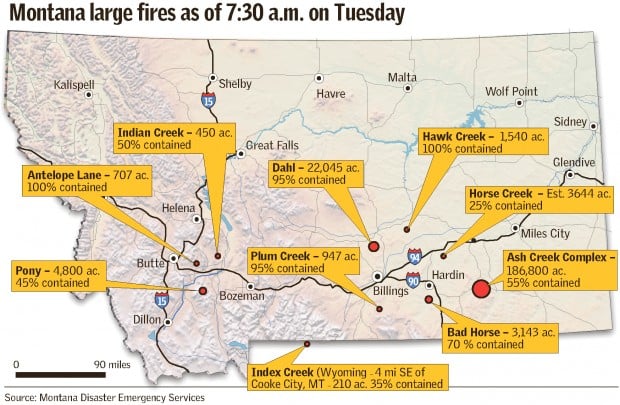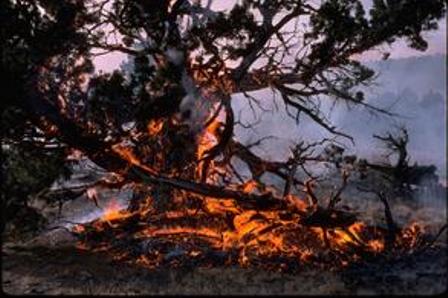This is another question that came up while I was away on vacation. When those wildfires were burning in Colorado and elsewhere, news reports kept saying things like, "The fire is 30% contained," or "The fire is estimated to be 45% contained." In one news story I heard on the radio, the reporter asked the fire chief how he calculated containment. He said something about the amount of acreage involved, but he said it so quickly, I didn't catch it.
So I wanted to find out, how do they calculate what percentage of a wildfire is contained?

Wildfire taking out trees as it moves across the ground.
(Photo from Chez-Audelle)

On July 4, 2012, several wildfires were burning across the state of Montana. The percent containment figures make for a nice, neat graphic, don't they?
(Map from the Billings Gazette)
Percent Containment

Actual Containment: My Take

I find this to be a pretty fascinating map. This is a map of the High Park Fire in Colorado as of June 21, 2012. The red area represents where the fire was burning on that date. The red outline is the "uncontrolled fire edge." The black outline is the "completed line," meaning where they have put some sort of fire control measure in please. The map is very detailed, even including gray-shaded areas where an older fire once burned. But nowhere does it say anything about containment--presumably because, according to firefighter parlance, containment had not yet been reached. To see a larger version of the map, go to Summit County Citizens Voice.
(Map from Summit County Citizens Voice)


Obviously the intensity of the wildfire above is far greater than the one below.
(Photo, top from Treehugger. Photo, bottom from US Fish & Wildlife Service, sourced from Wildlife Risk Explorer)

Firefighters working on a wildfire in Australia
(Photo from Chez-Audelle)
Related entries: Fire, Fire Departments
Sources
Forest Encyclopedia Network. All sorts of great information here. Especially good pages include Fire Intensity, Fireline Intensity, Rate of Spread,
National Wildfire Coordinating Group, Contained; Containment; Control Line; Controlled
Frank A. Albini and Carolyn H. Chase, Fire Containment Equations for Pocket Calculators, USDA Forest Service INT-26B, January 1980
LAist, What Do Fire Officials Mean When They Say 'Containment'? 2008
Rebane's Ruminations, Wildfire Containment Percentage - Say What??!! August 18, 2009
So I wanted to find out, how do they calculate what percentage of a wildfire is contained?

Wildfire taking out trees as it moves across the ground.
(Photo from Chez-Audelle)

On July 4, 2012, several wildfires were burning across the state of Montana. The percent containment figures make for a nice, neat graphic, don't they?
(Map from the Billings Gazette)
Percent Containment
- It turns out, there isn't any fancy calculation involved in arriving at percent containment. It's an estimate. Here's how it works.
- A wildfire encompasses a certain amount of area. Imagine the area as a filled-in ellipse. Most wildfires aren't like that; they'll often have portions bulging out in one direction or other, but for the ease of description, picture an ellipse. The outer edge of the ellipse is the fireline.
- When firefighters try to put out the wildfire, their first goal is to stop it from spreading. They may put up some kind of temporary barrier around the fireline, or they may dig trenches, or they may spread some type of retardant, or they may remove trees or easily burnable stuff from the projected path of the fire, etc. All these techniques are methods of containment.
- When the fire chief gets interviewed and is asked some question like, "How close are you to getting this fire under control?" the fire chief tells the reporter what percent of the ellipse has some kind of containment barrier around the fireline.
- That's all there is to it. There's nothing absolute about it. It's an estimate based on the chief's understanding of the size of the fire at the time, and how much of a barrier they've put down so far.

Today,
most wildfire containment methods use retardant dropped onto areas just
beyond the fireline, as shown in this photo of the Waldo Canyon Fire,
June 23, 2012
(Photo from The Colorado Springs Gazette) Actual Containment: My Take
- Based on what I've read, it sounds to me like this % containment number is a number they tell the media to make them happy. It's a number to give to the reporters (and to us the public) so we can feel like we have a solid and easy-to-grasp concept to cling to. But as far as I can tell, firefighters do not themselves think in such terms.
- To them, containment = 100% contained. The question for them is, how do we get from this fire burning out of control to 100% contained, and put out?

I find this to be a pretty fascinating map. This is a map of the High Park Fire in Colorado as of June 21, 2012. The red area represents where the fire was burning on that date. The red outline is the "uncontrolled fire edge." The black outline is the "completed line," meaning where they have put some sort of fire control measure in please. The map is very detailed, even including gray-shaded areas where an older fire once burned. But nowhere does it say anything about containment--presumably because, according to firefighter parlance, containment had not yet been reached. To see a larger version of the map, go to Summit County Citizens Voice.
(Map from Summit County Citizens Voice)
- To answer this question, firefighters run all sorts of calculations--very complicated ones involving calculus and all sorts of higher math because there are so many variables involved in a wildfire.
- Here are some of the features about a wildfire that firefighters have to take into account:
- Fire intensity -- the rate of heat released by a fire. That's both radiant and convectional heat.
- Rate of spread -- the distance the fire moves horizontally over time. Usually this is calculated at the head of the fire.
- Fire type -- is it burning at surface or ground level, or is it burning in the crowns of trees
- Type of fuel -- usually when it's a wildfire, it's mostly wood and leaves that's involved, but maybe there are other materials in the area, especially if there are houses or industrial buildings. Even if the fuel is nearly all wood, there are other factors to consider such as how wet is the wood, is it densely or loosely arranged, how big or small is it (fine fuels like sawdust ignite much more rapidly), how dense is the material (a rotten log will ignite more quickly than a sound log), and so on.
- Fuel load -- weight of fuel/unit area, often expressed as tons/acre
- Fuel chemical composition -- if there are chemicals identified in your type of fuel, what kinds of chemicals are they? Of course if accelerants are involved, everything burns faster & hotter. But even if the fuel is primarily wood, high concentrations of resins or oils in the wood can increase flammability and heat output. On the other hand, if the wood has a high mineral content, particularly phosphorus, that will reduce or even retard flammability.
- Weather -- we hear the most about this one. All sorts of factors with the weather come into play, including how fast is the wind blowing and is it blowing the fire toward unburned fuel areas. Of course whether or not it's going to rain is a huge factor, but air temperature and humidity will also affect the fire.


Obviously the intensity of the wildfire above is far greater than the one below.
(Photo, top from Treehugger. Photo, bottom from US Fish & Wildlife Service, sourced from Wildlife Risk Explorer)
- As I said, those are only some of the variables the firefighters will take into account. Some of those variables are easier to estimate than others.
- Then they take all that data and plug them into those very complicated equations to try to find the answers to questions like these:
- What kind of material would be the most effective at stopping the fire?
- How much of that material will we need to create barriers around the entire fire?
- How fast will we need to build those barriers?
- How long will it take to reach 100% containment, given such & such barriers?
- Put in a very theoretical sense, firefighters are trying to solve the fire (equation) for containment (x).
- (If you're interested in what some of those complicated equations are, check out this paper from 1980. It gives instructions for how to run some of these equations on a pocket calculator. To run them yourself, you would need to know the data for at least 8 variables. I'm sure there are more sophisticated methods of running these calculations today, but this gives you an early, behind-the-scenes glance anyway.)

Firefighters working on a wildfire in Australia
(Photo from Chez-Audelle)
- Of course, regardless of all this data, a wildfire is still wild. Even though firefighters do their very best to find out everything they can about a particular fire and how it's behaving, and try to predict where it might go next and how fast it might get there, a wildfire can still be unpredictable.
- That's not something we like to hear, especially if homes are at risk of being burned and people's lives may be at risk. So we get a very estimatey-but-it-sounds-official percent containment number in our news stories.
Related entries: Fire, Fire Departments
Sources
Forest Encyclopedia Network. All sorts of great information here. Especially good pages include Fire Intensity, Fireline Intensity, Rate of Spread,
National Wildfire Coordinating Group, Contained; Containment; Control Line; Controlled
Frank A. Albini and Carolyn H. Chase, Fire Containment Equations for Pocket Calculators, USDA Forest Service INT-26B, January 1980
LAist, What Do Fire Officials Mean When They Say 'Containment'? 2008
Rebane's Ruminations, Wildfire Containment Percentage - Say What??!! August 18, 2009
No comments:
Post a Comment
If you're a spammer, there's no point posting a comment. It will automatically get filtered out or deleted. Comments from real people, however, are always very welcome!